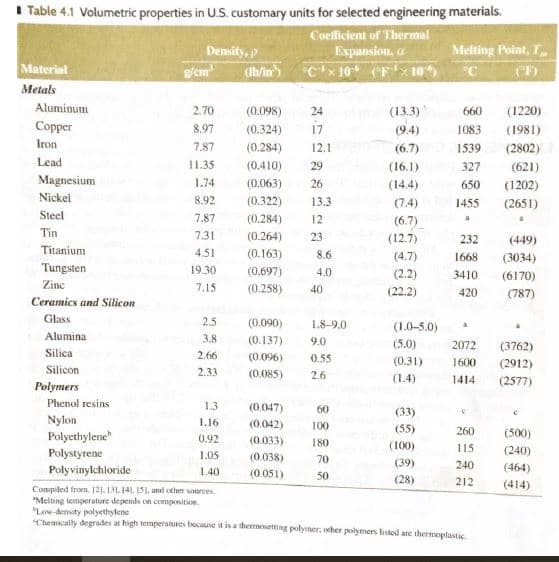M4.16 Determine the increase in length of a steel bar whose length 100 in, if the bar is heated from room temperature of 70°F to 500°F. Use Table 4.1from the book for reference. Round to the nearest 1000th of an inch Table 4.1 Volumetric properties in U.S. customary units for selected engineering materials Coclicient of Thermal Expansion, a Cx10F10 Melting Point, T Density, p g/em Material Metals Aluminum 2.70 (0.098) (13.3) 660 (1220) 24 Copper 8.97 (0.324) 17 1083 (1981) (94) Iron 7.87 (0.284) 12.1 (6.7) 1539 (2802) Lead 11.35 (0.410) 29 (621) (16.1) 327 Magnesium 1.74 (0.063) 26 (144) 650 (1202) Nickel 8.92 (0.322) 13.3 (7.4) (2651) 1455 Steel (0.284) 7.87 12 (6.7) a Tin 7.3 (0.264) 23 (12.7) 232 (449) Titanium 4.51 (0.163) 8.6 (4.7) 1668 (3034) Tungsten 19.30 (0.697) 4.0 (2.2) 3410 (6170) Zinc 7.15 (0.258) 40 (22.2) 420 (787) Ceramics and Silicon Glass 2.5 (0.090) 1.8-9.0 (1.0-5.0) Alumina 3.8 (0.137) 9.0 (5.0) 2072 (3762) Silica 2.66 (0.096) 0.55 (0.31) 1600 (2912) Silicon 2.33 (0.085) 2.6 (1.4) 1414 (2577) Polymers Phenol resins 1.3 (0.047) 60 (33) Nylon Polyethylene I.16 (0042) 100 (55) 260 (500) 0.92 (0.033) 180 (100) 115 (240) Polystyrene 1.05 (0.038) 70 (39) 240 (464) Polyvinylchloride 140 (0.051) 50 (28) 212 (414) Compiled from. 121.131. 141. 15). and other sources Melting tesmperature depends on composition Low-density polyethylene Chemically degrades at high temperanures because it is a thermosetting polymer, ocher polymers listed are thermoplastic
M4.16 Determine the increase in length of a steel bar whose length 100 in, if the bar is heated from room temperature of 70°F to 500°F. Use Table 4.1from the book for reference. Round to the nearest 1000th of an inch Table 4.1 Volumetric properties in U.S. customary units for selected engineering materials Coclicient of Thermal Expansion, a Cx10F10 Melting Point, T Density, p g/em Material Metals Aluminum 2.70 (0.098) (13.3) 660 (1220) 24 Copper 8.97 (0.324) 17 1083 (1981) (94) Iron 7.87 (0.284) 12.1 (6.7) 1539 (2802) Lead 11.35 (0.410) 29 (621) (16.1) 327 Magnesium 1.74 (0.063) 26 (144) 650 (1202) Nickel 8.92 (0.322) 13.3 (7.4) (2651) 1455 Steel (0.284) 7.87 12 (6.7) a Tin 7.3 (0.264) 23 (12.7) 232 (449) Titanium 4.51 (0.163) 8.6 (4.7) 1668 (3034) Tungsten 19.30 (0.697) 4.0 (2.2) 3410 (6170) Zinc 7.15 (0.258) 40 (22.2) 420 (787) Ceramics and Silicon Glass 2.5 (0.090) 1.8-9.0 (1.0-5.0) Alumina 3.8 (0.137) 9.0 (5.0) 2072 (3762) Silica 2.66 (0.096) 0.55 (0.31) 1600 (2912) Silicon 2.33 (0.085) 2.6 (1.4) 1414 (2577) Polymers Phenol resins 1.3 (0.047) 60 (33) Nylon Polyethylene I.16 (0042) 100 (55) 260 (500) 0.92 (0.033) 180 (100) 115 (240) Polystyrene 1.05 (0.038) 70 (39) 240 (464) Polyvinylchloride 140 (0.051) 50 (28) 212 (414) Compiled from. 121.131. 141. 15). and other sources Melting tesmperature depends on composition Low-density polyethylene Chemically degrades at high temperanures because it is a thermosetting polymer, ocher polymers listed are thermoplastic
International Edition---engineering Mechanics: Statics, 4th Edition
4th Edition
ISBN:9781305501607
Author:Andrew Pytel And Jaan Kiusalaas
Publisher:Andrew Pytel And Jaan Kiusalaas
Chapter9: Moments And Products Of Inertia Of Areas
Section: Chapter Questions
Problem 9.94RP: The properties of the unequal angle section are Ix=80.9in.4,Iy=38.8in.4, and Iu=21.3in.4. Determine...
Related questions
Question

Transcribed Image Text:M4.16 Determine the increase in length of a steel bar whose length 100 in, if the bar is heated from
room temperature of 70°F to 500°F. Use Table 4.1from the book for reference. Round to the nearest
1000th of an inch

Transcribed Image Text:Table 4.1 Volumetric properties in U.S. customary units for selected engineering materials
Coclicient of Thermal
Expansion, a
Cx10F10
Melting Point, T
Density, p
g/em
Material
Metals
Aluminum
2.70
(0.098)
(13.3)
660
(1220)
24
Copper
8.97
(0.324)
17
1083
(1981)
(94)
Iron
7.87
(0.284)
12.1
(6.7)
1539
(2802)
Lead
11.35
(0.410)
29
(621)
(16.1)
327
Magnesium
1.74
(0.063)
26
(144)
650
(1202)
Nickel
8.92
(0.322)
13.3
(7.4)
(2651)
1455
Steel
(0.284)
7.87
12
(6.7)
a
Tin
7.3
(0.264)
23
(12.7)
232
(449)
Titanium
4.51
(0.163)
8.6
(4.7)
1668
(3034)
Tungsten
19.30
(0.697)
4.0
(2.2)
3410
(6170)
Zinc
7.15
(0.258)
40
(22.2)
420
(787)
Ceramics and Silicon
Glass
2.5
(0.090)
1.8-9.0
(1.0-5.0)
Alumina
3.8
(0.137)
9.0
(5.0)
2072
(3762)
Silica
2.66
(0.096)
0.55
(0.31)
1600
(2912)
Silicon
2.33
(0.085)
2.6
(1.4)
1414
(2577)
Polymers
Phenol resins
1.3
(0.047)
60
(33)
Nylon
Polyethylene
I.16
(0042)
100
(55)
260
(500)
0.92
(0.033)
180
(100)
115
(240)
Polystyrene
1.05
(0.038)
70
(39)
240
(464)
Polyvinylchloride
140
(0.051)
50
(28)
212
(414)
Compiled from. 121.131. 141. 15). and other sources
Melting tesmperature depends on composition
Low-density polyethylene
Chemically degrades at high temperanures because it is a thermosetting polymer, ocher polymers listed are thermoplastic
Expert Solution
This question has been solved!
Explore an expertly crafted, step-by-step solution for a thorough understanding of key concepts.
This is a popular solution!
Trending now
This is a popular solution!
Step by step
Solved in 2 steps with 2 images

Recommended textbooks for you

International Edition---engineering Mechanics: St…
Mechanical Engineering
ISBN:
9781305501607
Author:
Andrew Pytel And Jaan Kiusalaas
Publisher:
CENGAGE L

International Edition---engineering Mechanics: St…
Mechanical Engineering
ISBN:
9781305501607
Author:
Andrew Pytel And Jaan Kiusalaas
Publisher:
CENGAGE L